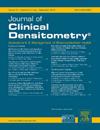Comparison of the Effect of Selective Serotonin and Norepinephrine Reuptake Inhibitors on Bone Mineral Density with Selective Serotonin Reuptake Inhibitors and Healthy Controls
IF 1.6
4区 医学
Q4 ENDOCRINOLOGY & METABOLISM
引用次数: 0
Abstract
Purpose: This study investigated the association between selective serotonin reuptake inhibitor (SSRI) and selective serotonin and norepinephrine reuptake inhibitor (SNRI) use and the risk of decreased bone mineral density in postmenopausal women.
Methods: Sixty-three patients diagnosed with GAD (Generalized Anxiety Disorder) were treated with venlafaxine or duloxetine from the SNRI group, and sixty patients treated with SSRIs were enrolled. Social demographic features, the Hamilton Anxiety Scale (HAS) results, and the Hamilton Depression Scale (HDS) scores of all the patients were assessed. The BMD (bone mineral density) of the patients was measured by dual-energy X-ray absorptiometry (DXA) at the femoral and lumbar regions. The BMD of the patients was compared with that of 40 healthy controls.
Results: Bone measurements in the SNRI and SSRI users were similar to those of the healthy controls. However, osteopenic values were observed in the SSRI users, while normal bone density was found in the SNRI users. Also, the bone mineral densities were compared between patients using duloxetine and venlafaxine with healthy controls, showing similar T-score and Z-score values with no significant differences compared to the control group. However, while the lumbar region T-scores of those using duloxetine were within normal values, they were within the osteopenia range of venlafaxine and healthy controls.
Conclusion: SNRIs may have a lower risk of developing osteoporosis than SSRIs. Of the SNRIs, duloxetine appears to be safer than venlafaxine. Further randomized controlled studies are warranted to determine whether SNRI use is risky.
选择性羟色胺和去甲肾上腺素再摄取抑制剂对骨矿密度的影响与选择性羟色胺再摄取抑制剂和健康对照组的比较。
目的:本研究调查了绝经后妇女使用选择性5-羟色胺再摄取抑制剂(SSRI)和选择性5-羟色胺及去甲肾上腺素再摄取抑制剂(SNRI)与骨矿物质密度下降风险之间的关系:63名被诊断为GAD(广泛性焦虑症)的患者接受了SNRI组的文拉法辛或度洛西汀治疗,60名患者接受了SSRIs治疗。对所有患者的社会人口学特征、汉密尔顿焦虑量表(HAS)结果和汉密尔顿抑郁量表(HDS)评分进行了评估。通过双能 X 射线吸收仪(DXA)测量了患者股骨和腰椎部位的骨密度(BMD)。将患者的骨密度与 40 名健康对照者的骨密度进行了比较:结果:SNRI 和 SSRI 使用者的骨骼测量值与健康对照组相似。然而,SSRI 使用者出现骨质疏松,而 SNRI 使用者的骨密度正常。此外,使用度洛西汀和文拉法辛的患者与健康对照组的骨矿物质密度也进行了比较,结果显示两者的 T 值和 Z 值相似,与对照组相比无显著差异。然而,虽然使用度洛西汀的患者腰椎部位的T值在正常值范围内,但文拉法辛和健康对照组的腰椎部位的T值却在骨质疏松范围内:结论:与 SSRI 相比,SNRI 类药物患骨质疏松症的风险较低。在 SNRIs 中,度洛西汀似乎比文拉法辛更安全。需要进一步开展随机对照研究,以确定服用 SNRI 是否有风险。
本文章由计算机程序翻译,如有差异,请以英文原文为准。
求助全文
约1分钟内获得全文
求助全文
来源期刊

Journal of Clinical Densitometry
医学-内分泌学与代谢
CiteScore
4.90
自引率
8.00%
发文量
92
审稿时长
90 days
期刊介绍:
The Journal is committed to serving ISCD''s mission - the education of heterogenous physician specialties and technologists who are involved in the clinical assessment of skeletal health. The focus of JCD is bone mass measurement, including epidemiology of bone mass, how drugs and diseases alter bone mass, new techniques and quality assurance in bone mass imaging technologies, and bone mass health/economics.
Combining high quality research and review articles with sound, practice-oriented advice, JCD meets the diverse diagnostic and management needs of radiologists, endocrinologists, nephrologists, rheumatologists, gynecologists, family physicians, internists, and technologists whose patients require diagnostic clinical densitometry for therapeutic management.
 求助内容:
求助内容: 应助结果提醒方式:
应助结果提醒方式:


